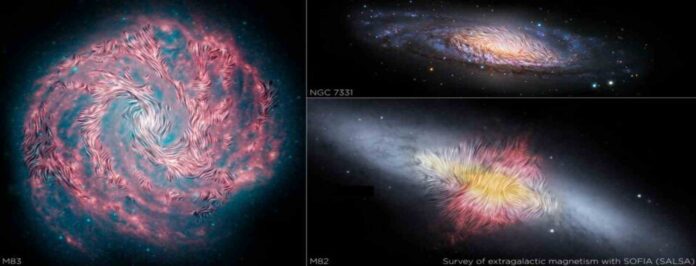Magnetic fields are common throughout the universe but incredibly incredibly challenging to study. They don’t directly emit or reflect light, and light from all along the electromagnetic spectrum remains the primary purveyor of astrophysical data. Instead, researchers have had to find the equivalent of cosmic iron filings—matter in galaxies that is sensitive to magnetic fields and also emits light marked by the fields’ structure and intensity.
In a new study published in The Astrophysical Journal, several Stanford astrophysicists have studied infrared signals from just such a material—magnetically aligned dust grains embedded in the cold, dense clouds of star-forming regions. A comparison to light from cosmic ray electrons that has been marked by magnetic fields in warmer, more diffuse material showed surprising differences in the measured magnetic fields of galaxies.
Stanford astrophysicist and member of the Kavli Institute for Particle Acceleration and Cosmology (KIPAC) Enrique Lopez-Rodriguez explains the differences and what they could mean for galactic growth and evolution.
Originally from the Canary Islands, Lopez-Rodriguez came to the Bay Area as a scientist with the Stratospheric Observatory for Infrared Astronomy (SOFIA), the Boeing 737 jetliner modified to carry instruments above most of the atmospheric dust and water vapor that blocks infrared light. Before the SOFIA program ended in 2022, Lopez-Rodriguez joined Stanford, where he continues to analyze legacy SOFIA data as one of the principal investigators of SALSA, the Survey of extragALactic MagnetiSm with SOFIA.
This interview has been edited for clarity and brevity.
Can you describe your findings? What makes them so groundbreaking?
This is the first study comparing magnetic fields in different physical environments of other galaxies. To do that we looked at 15 different nearby galaxies in both radio and far-infrared wavelengths. We have two different principal investigators for this study: myself for the infrared data and Sui Ann Mao at the Max Planck Institute for Radio Astronomy in Germany for the radio data.
Our groups found two very different magnetic fields in the same galaxies. Radio observations trace a very ordered magnetic field in the ionized, warm, and diffuse medium one to two kiloparsecs above the galactic disks we studied [one kiloparsec is 3,260 light years], while far infrared light emitted by magnetically aligned dust grains in the midplane of the disks shows a magnetic field that is almost twice as chaotic. In summary, areas with greater star formation had stronger and more chaotic magnetic fields.
What do these chaotic magnetic fields tell us?
Spiral arms have tangled magnetic fields due to star formation activity and the formation of molecular clouds, which indicates high levels of turbulence and potentially a place where magnetic fields may be amplified. In contrast, the regions between the arms of spiral galaxies and in the medium above and below the disk have well-ordered magnetic fields, which indicates that galaxy rotation may be playing a role in the ordering of these magnetic fields.
In general, we don’t know the role of magnetic fields in galaxy evolution, but these far-infrared observations tell us that magnetic fields are intrinsically related to star-forming areas, which is key to galaxy formation. We don’t know exactly how they’re related but we think there might be some kind of feedback loop between the two.
What’s next? How will you look for the nature of the feedback loop?
With this result, we can now produce three-dimensional studies of the magnetic fields in other galaxies that will help us study their effects on star formation activity and galaxy evolution.
But we also need observations with higher angular resolution so we can get a closer look at the star-forming regions, and we also need to study the magnetic fields across cosmic time. The good news is that we’re already getting that sort of data with ALMA (the Atacama Large Millimeter/submillimeter Array). In addition, the next generation of NASA space missions also include the same types of far-infrared polarimetric observations we used, only better, to study the magnetic fields in a statistical sample of galaxies.
Several other Stanford researchers are involved in the study as well. How did you all come together here?
For myself, at NASA I was an instrument scientist and flew more than 100 times with SOFIA—although each flight was an adventure, it was too many times for me, really. Most of the observations we used in this study I took myself with HAWC+ [the High-resolution Airborne Wideband Camera+, a far-infrared imager and polarimeter]. I knew the instrument and how to work with the data, and created a new observing mode that improved the sensitivity and observing acquisition time by 300%. My research focuses on the study of magnetic fields in galaxies, and since I was already working closely with the instrument, data acquisition, and analysis, this project was a perfect match.
After SOFIA I wanted to do full-time science and KIPAC opened the door very nicely for me. Especially when I found out [Assistant Professor] Susan Clark was coming here too and realized her research goals matched very well with mine. We also have Mehrnoosh [Tahani], who studies the magnetic fields in the Milky Way in radio, Sergio [Martin-Alvarez], who does magneto-hydro-dynamic simulations, and Alex [Alejandro S. Borlaff], who is visiting from NASA-Ames as a NASA postdoctoral fellow.
Now we have a wide range of expertise in magnetism here at Stanford, which makes us a unique team perfectly situated to extract the most science out of these SALSA observations.
Reference:
Alejandro S. Borlaff et al, Extragalactic Magnetism with SOFIA (SALSA Legacy Program). V. First Results on the Magnetic Field Orientation of Galaxies, The Astrophysical Journal (2023). DOI: 10.3847/1538-4357/acd934
